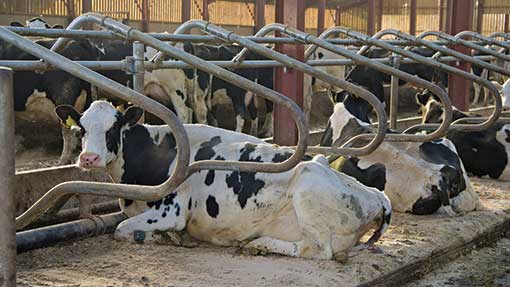Livestock event 2014: Cow comfort linked to milk yields

Improving dairy cow comfort can reduce lameness and increase milk yields, farmers at the 2014 Livestock Event were told.
The Royal Veterinary College’s Dr Nick Bell said the link between cow comfort and milk production could not be ignored.
“Bed comfort comes first and ideally this should be a deep sand bed,” he said.
Trials by Dr Bell on a Dorset dairy farm where cows had hock swellings and ulcers, found switching from mattresses to deep sand beds increased milk yield from 8,200 litres a cow a year to just under 10,000.
Lying time also increased from 11 to 13 hours a day after improving bed comfort.
Studies in Wisconsin also showed lameness was reduced by one third in deep sand beds, he added.
See also: Free online learning with our Academy on cattle housing
Underfoot surfaces
Dr Bell said different surfaces are often needed in key areas of the farm but warned farmers to shop around and view people’s work before getting them in for concrete grooving.
- Grooves are needed in areas cows are likely to slip
- The feed area requires a scabbled [textured] surface for grip
- Rubber matting should run along the feed fence for comfort
“Tampered or brushed finishes are far from perfect as they get smooth relatively quickly and cows can slip causing increased trauma to the feet.
“I think the scabbled effect is one of the best (most popular in New Zealand and France), but doesn’t give purchase for the cow to get up if she falls, unlike grooves. An 80mm square with a 60mm grooved ridge is hard to beat, whereas hexagon patterns take experience to get a consistent imprint.”
Dr Bell reported the US favour a deep grooved pattern to save cows as they can get up again, however he said this surface is not dissimilar to slats used in the UK and evidence has proven these can cause foot problems.
“Abrasive and uneven surfaces cause sole bruising and white line lesions,” he added.
Other influences
Dr Bell also advised farmers to check standing times at milking and cubicle design, which if poorly designed can put cows off from getting up as they hit the neck rail or damage hocks.
“Three times a day milking can influence the amount of time cows have in the cubicles. They should be back [in the cubicle shed] in under an hour, no more than three; and those achieving this see improvements in cow foot health.”
See also: All the coverage from the Livestock Event 2014
